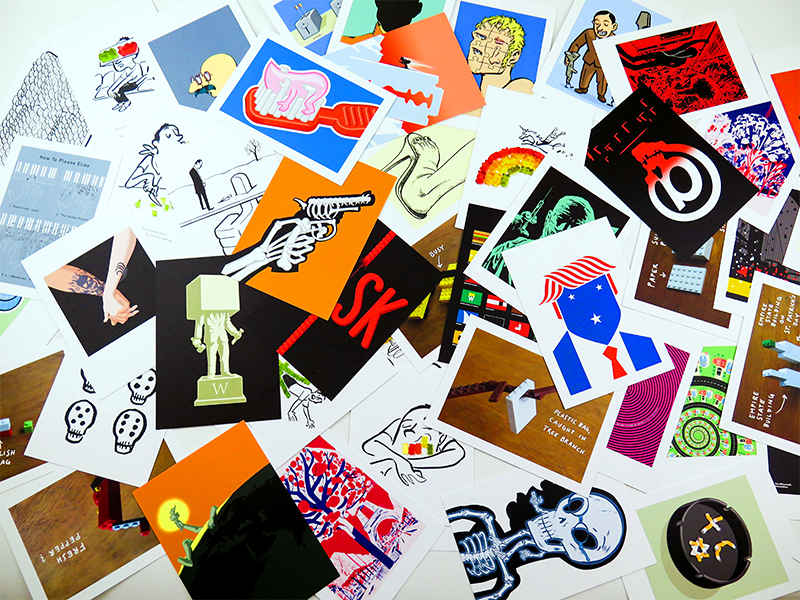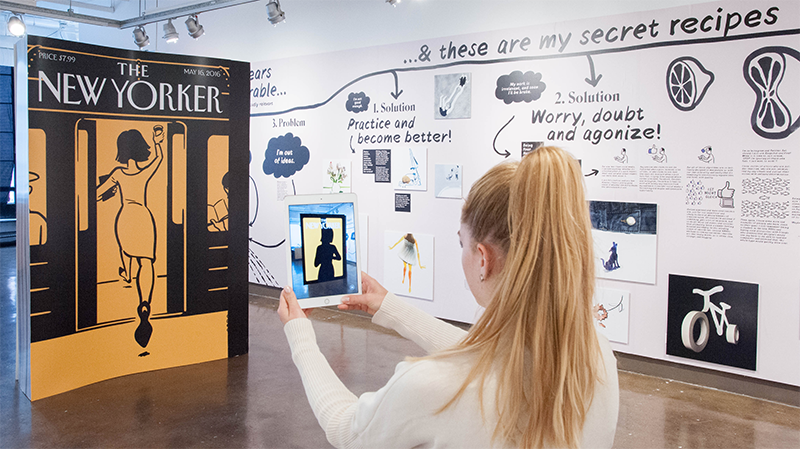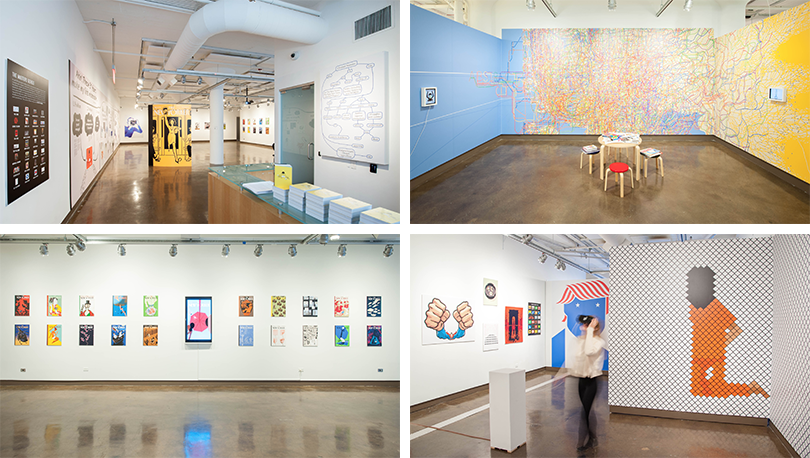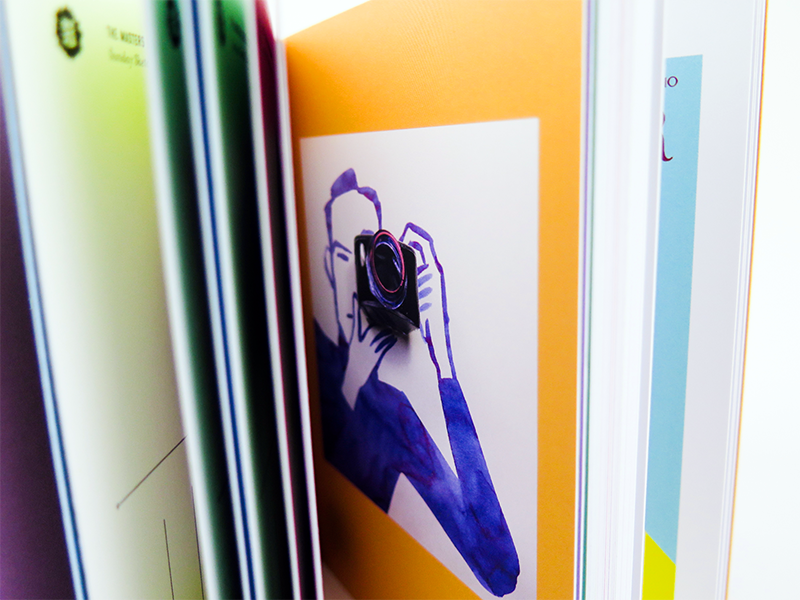
Photo: Declan Van Welie
Illustrator, author, and designer Christoph Niemann’s work for magazines, books and, well, you name it, is now on view at the School of Visual Arts Masters Series: Christoph Niemann. The exhibit, designed by Francis DiTomasso, is at the SVA Chelsea Gallery, 601 West 26th St. 15th Floor until Saturday November 4. A Masters Series keepsake book of postcards designed by the Visual Arts Press is available. The following is the introduction to that catalog. — The Editors
It takes special creative agility to produce editorial illustrations that transcend ephemerality yet capture the essence of a particular moment, to turn abstract marks into signs, glyphs, symbols, characters, and conceptions that compellingly impact the emotions and intellect of an audience, to channel the right image at the right time for the right result. Christoph Niemann is blessed with this gift. It is anyone’s guess how his incredible fluency with the language of symbolic and metaphoric imagery was so expertly honed—and in such a relatively short time, too. Being a romantic, I like to believe that he (and a few others like him) was placed on Earth with creative powers that allow him to “speak” in universal visual tongues for the benefit of humankind. Nonetheless, I have no explanation for why these powers reside with him, so it remains a mystery worthy of investigation.
We know that Niemann is indeed the product of the reputable State Academy of Fine Arts in Stuttgart, Germany, and that one of his mentors was the late, great Heinz Edelmann. Yet many other illustrators went through the same process without achieving the same “chosen” status. In the world of applied art there are illustrators, and then there are ILLUSTRATORS. The best of the former are adept at the difficult feat of visualizing ideas in iconic ways. The best of the latter go a few steps further by digging deep into the viewer’s perceptions. As an interpreter of political, social, and cultural issues and events, Niemann uses pictures to untangle the inevitable jumble of confusions that confound the average brain. His drawings clarify the chaos, which enables readers to better comprehend various levels of complexity.

Photography by Ryan Sobotka
In the late ’90s, I was art director at The New York Times Book Review and Paula Scher introduced me to her summer intern—Christoph Niemann. I immediately realized that this was no ordinary illustrator/designer. Although a trifle “gawkward,” he was surprisingly articulate about art and its role as a mass communication tool. He had a mature understanding of the power of pictures and the difference between how gags and commentaries worked in driving public opinion and comprehension. (We were both Knicks fans, too, and that was just one aspect of the kinship he had with American culture.)
Yet these initial impressions, nice as they were, gave no indication to how special and, later, integral to my professional life he would become. Niemann had yet to actually perform his magic. But perform he soon did. Even minor assignments resulted in a barrage of great ideas (or “idears,” as he called them). I came to almost slavishly rely on his capacity to come to my rescue whenever I was stuck. Most times, I did not have to utter a word of direction; when I did, it was usually superfluous. He would have a solution to the problem before I even finished telling him what it was. Over the phone, I could hear the dopamine in his brain pumping away. Within minutes, sketches poured out from the nearby fax machine, each one slightly more spot on than the last—and not just refinements of one idea but often a half-dozen distinct concepts.
Niemann was a veritable illustration Superman, able to leap beyond the clichés of regurgitated editorial subject matter with a single bound. Though disguised as an unassuming, tall, lanky, bespectacled nerd (sorry, Christoph), he had such sophisticated translation skills for a kid in his early 20s that I was awestruck by his almost flawless capacity to forgo the obvious and by force of will pull from his head original images, perfectly conceived. Over the few years we worked together, I watched as his conceptual capabilities exponentially increased every time another art director at another publication employed his gifts. “My destination is no longer a place, rather a new way of seeing,” wrote Marcel Proust, as if to describe the essence of Niemann’s speedy evolution.

Photography by Ryan Sobotka
“My work has changed quite a bit since I started, in format, style, and approach,” Niemann says. “All these changes have felt personal and subjective. But when I look back, I see that they have followed larger trends in the industry: from the idea-driven editorial assignments of the late ’90s to the early 2000s, to the ‘illustrator as author’ essays of the 2000s to the 2010s, to the idea of working directly with an audience next to the established platforms of magazines, newspapers and books.”
In this self-estimation, Niemann is characteristically modest. While I consider his rise to be meteoric, and his status among the all-time greats inarguable, he has always been much more restrained about his development and his talents. When I suggest that the reason he is so routinely on target is because he harbors a vast and innate reservoir of ideas, he says, “I don’t have a store of ideas, sadly. What I do have is a store of images that I run through and that I try to combine in unexpected ways. The challenge is to update that store of images, because visually and culturally the world constantly changes.”
Fair enough, but his thought process must be lightning fast, no? “This process of recombining these images and ideas is slow and unsexy,” he says. “I go through endless nonsensical iterations before something like an idea forms itself. And to make sure an idea actually does make sense, I need to stare at it for quite some time. The proverbial aha moment is what the reader should experience when they end up looking at the piece—for me it has precious little relevance when creating.”
“I’m not sure if I can really think that well visually,” he says. “In order for an idea to come to life, it needs to grow on paper—or a screen. Sometimes, of course, a visual idea forms in my head, but these are usually just reiterations of things I’ve done or seen in the past. New things only start happening in the drawing process.”
Regardless, there are so many trains of thought leaving his mental station that choosing or editing the best option for an illustration is probably his biggest challenge. He says that when it comes to editing, “Nothing beats putting a concept away for a day or two and looking at it with a fresh set of eyes.” One way for him to select from his storage bank is “to rely on a small set of friends that I run things by. And I know that working with art directors over the years has benefited my work tremendously, even though at times they might fail to see the greatness of every single sketch I send them.”
If Niemann refuses to be boastful, I will on his behalf: He is a conceptual drawing machine. “Since all the work I do involves drawing, I don’t have to force myself to draw,” he once told me. “But recently I’ve found that it is very important to take more time to draw aimlessly—as an exercise, but also just to see what happens.” This perhaps accounts for the extensive range of approaches he uses; another explanation is that he doesn’t want to be locked into one style. “I studied graphic design,” he explains, “and that approach has informed the way I illustrate: A designer wouldn’t start with a typeface. You start with the idea, and then choose the right assets to make the idea come to life. I try to do the same with images. I’ve come to appreciate the power of keeping my artistic vanity in check.”
Speaking of vanity, he says what drives him—“maybe out of a youthful sense of insecurity”—is the audience’s reaction. “Whether you get through to a reader with an editorial drawing about interest rates or a watercolor drawing of a tree doesn’t make much of a difference to me.”

Photo: Declan Van Welie
In recent years, Niemann has been creating what I call “environmental” interventions—images that build on objects, photographs, and other real-life elements. These started as visual exercises, done out of his belief that so much of what an artist does is see images in a new way. “Eventually though, a certain routine sets in, and you develop a more predictable approach,” he says. “When I think of a chair, the image that pops up in my head is some bland stock photo version of a chair. Through this exercise, I want to challenge that stock photo image in my mind and force myself to really see objects. How do the elements line up when you look at them form a slightly different angle? How does real-world lighting affect the shape and volume?”
Niemann is riding on the crest of a mighty wave. His illustrations appear everywhere, and he is developing his own expressive projects. “I want to further explore what happens when I apply this open-ended approach of visual experiments to slightly more involved projects,” he says. “I’ve found that in order to be able to experiment, though, I need to be the one who operates the machinery. So the most important task is: I need to learn a lot more.”
This Masters Series exhibition represents a period of Niemann operating different machineries and honing his skills with all of them. Which makes me consider that maybe the key to his mysterious powers to influence, inform, and inspire through imagery is this: As he learns, his audience learns along with him.
